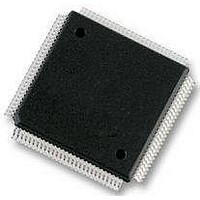MC9S12E128CPV Freescale Semiconductor, MC9S12E128CPV Datasheet - Page 510

MC9S12E128CPV
Manufacturer Part Number
MC9S12E128CPV
Description
Microcontrollers (MCU) 16 Bit 16MHz
Manufacturer
Freescale Semiconductor
Datasheet
1.MC9S12E128CPV.pdf
(606 pages)
Specifications of MC9S12E128CPV
Data Bus Width
16 bit
Program Memory Type
Flash
Program Memory Size
128 KB
Data Ram Size
8 KB
Interface Type
SCI, SPI
Maximum Clock Frequency
25 MHz
Number Of Programmable I/os
92
Number Of Timers
16 bit
Operating Supply Voltage
3.135 V to 5.5 V
Maximum Operating Temperature
+ 85 C
Mounting Style
SMD/SMT
Package / Case
LQFP-112
Minimum Operating Temperature
- 40 C
On-chip Adc
10 bit
On-chip Dac
8 bit, 2 Channel
Lead Free Status / Rohs Status
No RoHS Version Available
Available stocks
Company
Part Number
Manufacturer
Quantity
Price
Company:
Part Number:
MC9S12E128CPVE
Manufacturer:
Freescale Semiconductor
Quantity:
10 000
- Current page: 510 of 606
- Download datasheet (4Mb)
Chapter 17 Interrupt (INTV1)
17.5
The INT supports three system reset exception request types: normal system reset or power-on-reset
request, crystal monitor reset request, and COP watchdog reset request. The type of reset exception request
must be decoded by the system and the proper request made to the core. The INT will then provide the
service routine address for the type of reset requested.
17.6
As shown in the block diagram in
and control, an optional highest priority I interrupt (HPRIO) block, and a priority decoder to evaluate
whether pending interrupts are valid and assess their priority.
17.6.1
The INT registers are accessible only in special modes of operation and function as described in
Section 17.3.2.1, “Interrupt Test Control
previously.
17.6.2
When the optional HPRIO block is implemented, the user is allowed to promote a single I-bit maskable
interrupt to be the highest priority I interrupt. The HPRIO evaluates all interrupt exception requests and
passes the HPRIO vector to the priority decoder if the highest priority I interrupt is active. RTI replaces
the promoted interrupt source.
17.6.3
The priority decoder evaluates all interrupts pending and determines their validity and priority. When the
CPU requests an interrupt vector, the decoder will provide the vector for the highest priority interrupt
request. Because the vector is not supplied until the CPU requests it, it is possible that a higher priority
interrupt request could override the original exception that caused the CPU to request the vector. In this
case, the CPU will receive the highest priority vector and the system will process this exception instead of
the original request.
If for any reason the interrupt source is unknown (e.g., an interrupt request becomes inactive after the
interrupt has been recognized but prior to the vector request), the vector address will default to that of the
last valid interrupt that existed during the particular interrupt sequence. If the CPU requests an interrupt
vector when there has never been a pending interrupt request, the INT will provide the software interrupt
(SWI) vector address.
510
Resets
Interrupts
Interrupt Registers
Highest Priority I-Bit Maskable Interrupt
Interrupt Priority Decoder
Care must be taken to ensure that all exception requests remain active until
the system begins execution of the applicable service routine; otherwise, the
exception request may not be processed.
Figure
MC9S12E128 Data Sheet, Rev. 1.07
17-1, the INT contains a register block to provide interrupt status
Register,” and
NOTE
Section 17.3.2.2, “Interrupt Test
Freescale Semiconductor
Registers,”
Related parts for MC9S12E128CPV
Image
Part Number
Description
Manufacturer
Datasheet
Request
R
Part Number:
Description:
Manufacturer:
Freescale Semiconductor, Inc
Datasheet:
Part Number:
Description:
Manufacturer:
Freescale Semiconductor, Inc
Datasheet:
Part Number:
Description:
Manufacturer:
Freescale Semiconductor, Inc
Datasheet:
Part Number:
Description:
Manufacturer:
Freescale Semiconductor, Inc
Datasheet:
Part Number:
Description:
Manufacturer:
Freescale Semiconductor, Inc
Datasheet:
Part Number:
Description:
Manufacturer:
Freescale Semiconductor, Inc
Datasheet:
Part Number:
Description:
Manufacturer:
Freescale Semiconductor, Inc
Datasheet:
Part Number:
Description:
Manufacturer:
Freescale Semiconductor, Inc
Datasheet:
Part Number:
Description:
Manufacturer:
Freescale Semiconductor, Inc
Datasheet:
Part Number:
Description:
Manufacturer:
Freescale Semiconductor, Inc
Datasheet:
Part Number:
Description:
Manufacturer:
Freescale Semiconductor, Inc
Datasheet:
Part Number:
Description:
Manufacturer:
Freescale Semiconductor, Inc
Datasheet:
Part Number:
Description:
Manufacturer:
Freescale Semiconductor, Inc
Datasheet:
Part Number:
Description:
Manufacturer:
Freescale Semiconductor, Inc
Datasheet:
Part Number:
Description:
Manufacturer:
Freescale Semiconductor, Inc
Datasheet:











